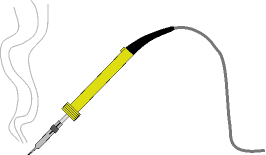

Types | Connecting | Soldering | Heat sinks | Testing | Codes | Choosing | Darlington pair
Also see: Heat sinks |
Transistor Circuits
 Transistors amplify current, for example they can be used to amplify the small output
current from a logic chip so that it can operate a lamp, relay or other high current device.
In many circuits a resistor is used to convert the changing current to a changing voltage,
so the transistor is being used to amplify voltage.
Transistors amplify current, for example they can be used to amplify the small output
current from a logic chip so that it can operate a lamp, relay or other high current device.
In many circuits a resistor is used to convert the changing current to a changing voltage,
so the transistor is being used to amplify voltage.
A transistor may be used as a switch (either fully on with maximum current, or fully off with no current) and as an amplifier (always partly on).
The amount of current amplification is called the current gain, symbol hFE.
For further information please see the Transistor Circuits page.
 | |
| Transistor circuit symbols | |
The leads are labelled base (B), collector (C) and emitter (E).
These terms refer to the internal operation of a transistor but they are not much
help in understanding how a transistor is used, so just treat them as labels!
A Darlington pair is two transistors connected together to give a very high current gain.
In addition to standard (bipolar junction) transistors, there are field-effect transistors which are usually referred to as FETs. They have different circuit symbols and properties and they are not (yet) covered by this page.
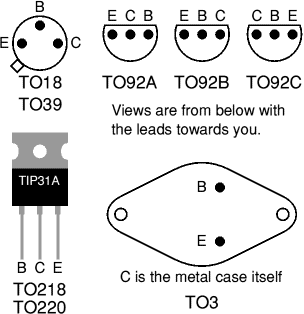 |
| Transistor leads for some common case styles. |
If you are lucky the orientation of the transistor will be clear from the PCB or stripboard layout diagram, otherwise you will need to refer to a supplier's catalogue to identify the leads.
The drawings on the right show the leads for some of the most common case styles.
Please note that transistor lead diagrams show the view from below with the leads towards you. This is the opposite of IC (chip) pin diagrams which show the view from above.
Please see below for a table showing the case styles of
some common transistors.
 |
| Crocodile clip Photograph © Rapid Electronics. |
Do not confuse this temporary heat sink with the permanent heat sink (described below)
which may be required for a power transistor to prevent it overheating during operation.
 |
| Heat sink Photograph © Rapid Electronics |
For further information please see the Heat sinks page.
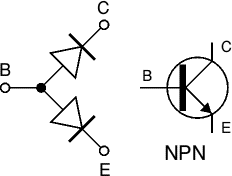 |
| Testing an NPN transistor |
Test each pair of leads both ways (six tests in total):
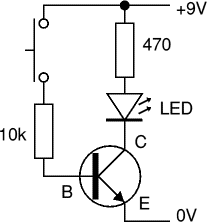 |
| A simple switching circuit to test an NPN transistor |
If the transistor is OK the LED should light when the switch is pressed and not light when the switch is released.
To test a PNP transistor use the same circuit but reverse the LED and the supply voltage.
Some multimeters have a 'transistor test' function which
provides a known base current and measures the collector current so as to display the
transistor's DC current gain hFE.
To make a final choice you will need to consult the tables of technical data which are normally provided in catalogues. They contain a great deal of useful information but they can be difficult to understand if you are not familiar with the abbreviations used. The table below shows the most important technical data for some popular transistors, tables in catalogues and reference books will usually show additional information but this is unlikely to be useful unless you are experienced. The quantities shown in the table are explained below.
| NPN transistors | ||||||||
| Code | Structure | Case style |
IC max. |
VCE max. |
hFE min. |
Ptot max. |
Category (typical use) |
Possible substitutes |
| BC107 | NPN | TO18 | 100mA | 45V | 110 | 300mW | Audio, low power | BC182 BC547 |
| BC108 | NPN | TO18 | 100mA | 20V | 110 | 300mW | General purpose, low power | BC108C BC183 BC548 |
| BC108C | NPN | TO18 | 100mA | 20V | 420 | 600mW | General purpose, low power | |
| BC109 | NPN | TO18 | 200mA | 20V | 200 | 300mW | Audio (low noise), low power | BC184 BC549 |
| BC182 | NPN | TO92C | 100mA | 50V | 100 | 350mW | General purpose, low power | BC107 BC182L |
| BC182L | NPN | TO92A | 100mA | 50V | 100 | 350mW | General purpose, low power | BC107 BC182 |
| BC547B | NPN | TO92C | 100mA | 45V | 200 | 500mW | Audio, low power | BC107B |
| BC548B | NPN | TO92C | 100mA | 30V | 220 | 500mW | General purpose, low power | BC108B |
| BC549B | NPN | TO92C | 100mA | 30V | 240 | 625mW | Audio (low noise), low power | BC109 |
| 2N3053 | NPN | TO39 | 700mA | 40V | 50 | 500mW | General purpose, low power | BFY51 |
| BFY51 | NPN | TO39 | 1A | 30V | 40 | 800mW | General purpose, medium power | BC639 |
| BC639 | NPN | TO92A | 1A | 80V | 40 | 800mW | General purpose, medium power | BFY51 |
| TIP29A | NPN | TO220 | 1A | 60V | 40 | 30W | General purpose, high power | |
| TIP31A | NPN | TO220 | 3A | 60V | 10 | 40W | General purpose, high power | TIP31C TIP41A |
| TIP31C | NPN | TO220 | 3A | 100V | 10 | 40W | General purpose, high power | TIP31A TIP41A |
| TIP41A | NPN | TO220 | 6A | 60V | 15 | 65W | General purpose, high power | |
| 2N3055 | NPN | TO3 | 15A | 60V | 20 | 117W | General purpose, high power | |
| Please note: the data in this table was compiled from several sources which are not entirely consistent! Most of the discrepancies are minor, but please consult information from your supplier if you require precise data. | ||||||||
| PNP transistors | ||||||||
| Code | Structure | Case style |
IC max. |
VCE max. |
hFE min. |
Ptot max. |
Category (typical use) |
Possible substitutes |
| BC177 | PNP | TO18 | 100mA | 45V | 125 | 300mW | Audio, low power | BC477 |
| BC178 | PNP | TO18 | 200mA | 25V | 120 | 600mW | General purpose, low power | BC478 |
| BC179 | PNP | TO18 | 200mA | 20V | 180 | 600mW | Audio (low noise), low power | |
| BC477 | PNP | TO18 | 150mA | 80V | 125 | 360mW | Audio, low power | BC177 |
| BC478 | PNP | TO18 | 150mA | 40V | 125 | 360mW | General purpose, low power | BC178 |
| TIP32A | PNP | TO220 | 3A | 60V | 25 | 40W | General purpose, high power | TIP32C |
| TIP32C | PNP | TO220 | 3A | 100V | 10 | 40W | General purpose, high power | TIP32A |
| Please note: the data in this table was compiled from several sources which are not entirely consistent! Most of the discrepancies are minor, but please consult information from your supplier if you require precise data. | ||||||||
| Structure | This shows the type of transistor, NPN or PNP. The polarities of the two types are different, so if you are looking for a substitute it must be the same type. |
| Case style | There is a diagram showing the leads for some of the most common case styles in the Connecting section above. This information is also available in suppliers' catalogues. |
| IC max. | Maximum collector current. |
| VCE max. | Maximum voltage across the collector-emitter junction.
You can ignore this rating in low voltage circuits. |
| hFE | This is the current gain (strictly the DC current gain).
The guaranteed minimum value is given because the actual value varies from
transistor to transistor - even for those of the same type!
Note that current gain is just a number so it has no units.
The gain is often quoted at a particular collector current IC which is usually in the middle of the transistor's range, for example '100@20mA' means the gain is at least 100 at 20mA. Sometimes minimum and maximum values are given. Since the gain is roughly constant for various currents but it varies from transistor to transistor this detail is only really of interest to experts. Why hFE? It is one of a whole series of parameters for transistors, each with their own symbol. There are too many to explain here. |
| Ptot max. | Maximum total power which can be developed in the transistor, note that a heat sink will be required to achieve the maximum rating. This rating is important for transistors operating as amplifiers, the power is roughly IC × VCE. For transistors operating as switches the maximum collector current (IC max.) is more important. |
| Category | This shows the typical use for the transistor, it is a good starting point when looking for a substitute. Catalogues may have separate tables for different categories. |
| Possible substitutes | These are transistors with similar electrical properties which will be suitable substitutes in most circuits. However, they may have a different case style so you will need to take care when placing them on the circuit board. |
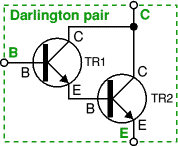 This is two transistors connected together so that the amplified current from the first
is amplified further by the second transistor. This gives the Darlington pair a very
high current gain such as 10000. Darlington pairs are sold as complete packages containing
the two transistors. They have three leads
(B, C and E)
which are equivalent to the leads of a standard individual transistor.
This is two transistors connected together so that the amplified current from the first
is amplified further by the second transistor. This gives the Darlington pair a very
high current gain such as 10000. Darlington pairs are sold as complete packages containing
the two transistors. They have three leads
(B, C and E)
which are equivalent to the leads of a standard individual transistor.
You can make up your own Darlington pair from two transistors.
For example:
